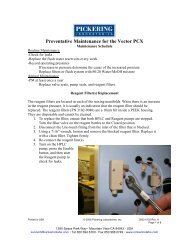to download our North American Product Catalog - Pickering ...
to download our North American Product Catalog - Pickering ...
to download our North American Product Catalog - Pickering ...
Create successful ePaper yourself
Turn your PDF publications into a flip-book with our unique Google optimized e-Paper software.
CHROMATOGRAMS, COLUMNS & GUARDSCATION-EXCHANGE GARD COLUMN PROTECTION SYSTEMThe new GARD uses a proprietary material <strong>to</strong> prevent matrix compounds from passing through (and thereby protecting theanalytical column), but allows the analytes of interest <strong>to</strong> pass unimpeded through the GARD and on<strong>to</strong> the analytical column.The new GARD signicantly prolongs column life without band spreading or added pressure. We demonstrated, bymeans of a performance comparison for Amino Acid Analysis, that the use of a GARD will effectively protect the analyticalcolumn, will be more cost-effective for the labora<strong>to</strong>ry, is easy <strong>to</strong> change, is universal <strong>to</strong> cation-exchange applications,and most importantly has zero band spreading.Wth the new GARD Column protection system from <strong>Pickering</strong> Labora<strong>to</strong>ries the same cation-exchange GARD can beused for nearly all cation-exchange applications.LITHIUM AMINO ACID ANALYSIS COLUMNS<strong>Pickering</strong> Labora<strong>to</strong>ries specialize in manufacturing of cation-exchange columns for amino acid analysis. No other techniques,including reversed-phase chroma<strong>to</strong>graphy, have been shown <strong>to</strong> match post-column ion-exchange methods in quantitationand reproducibility. Advantages of this method, such as absence of matrix interferences, are especially important inanalysis of native samples.Lithium columns and buffers systems have high selectivity and are perfect for physiological uids and food analysis.Post-column Conditions For Amino Acids Analysis:Reagent: Trione®Reac<strong>to</strong>r: 130 °C, 0.5 mLReagent Flow Rate: 0.3 mL/minDetection:UV-Vis Detec<strong>to</strong>r: =570 nm for primary amino acids=440 nm for secondary amino acidsorReagent: 300 mg of OPA, 2 g Thiouor, 3 mL of 30 %Brij® 35 solution in 950 mL of OD104Reac<strong>to</strong>r: 45 °C, 0.15 mLReagent Flow Rate: 0.3 mL/minDetection:Fluorometer: ex330 nm, em465 nmThe recommended gradient conditions are subject <strong>to</strong>change without notice. This may happen because of lotchanges in the columns, or improvements in the overallmethod.The recommended gradient for the column will alwaysbe included in the column package, and it supersedes theinformation in this catalog.<strong>Pickering</strong> Labora<strong>to</strong>ries recommends six different gradientconditions depending on the column and type of sample.Use the program recommended on the column data sheetfor the initial testing.The column oven temperature programming gives additionalexibility when optimizing methods. Using temperaturegradient allows <strong>to</strong> improve separation, shorten analysis timeand ne-tune the method for detecting compoundsof interest.



